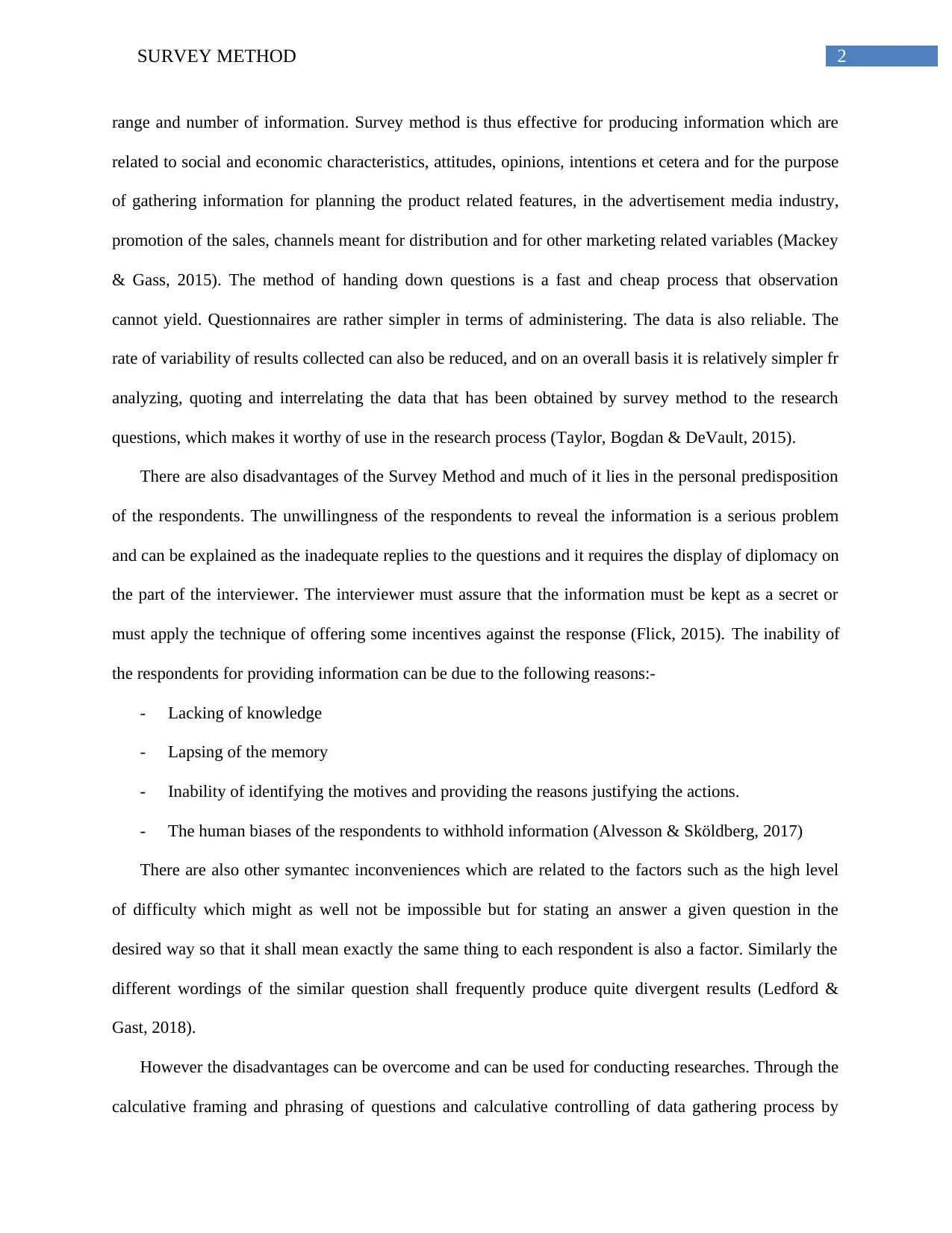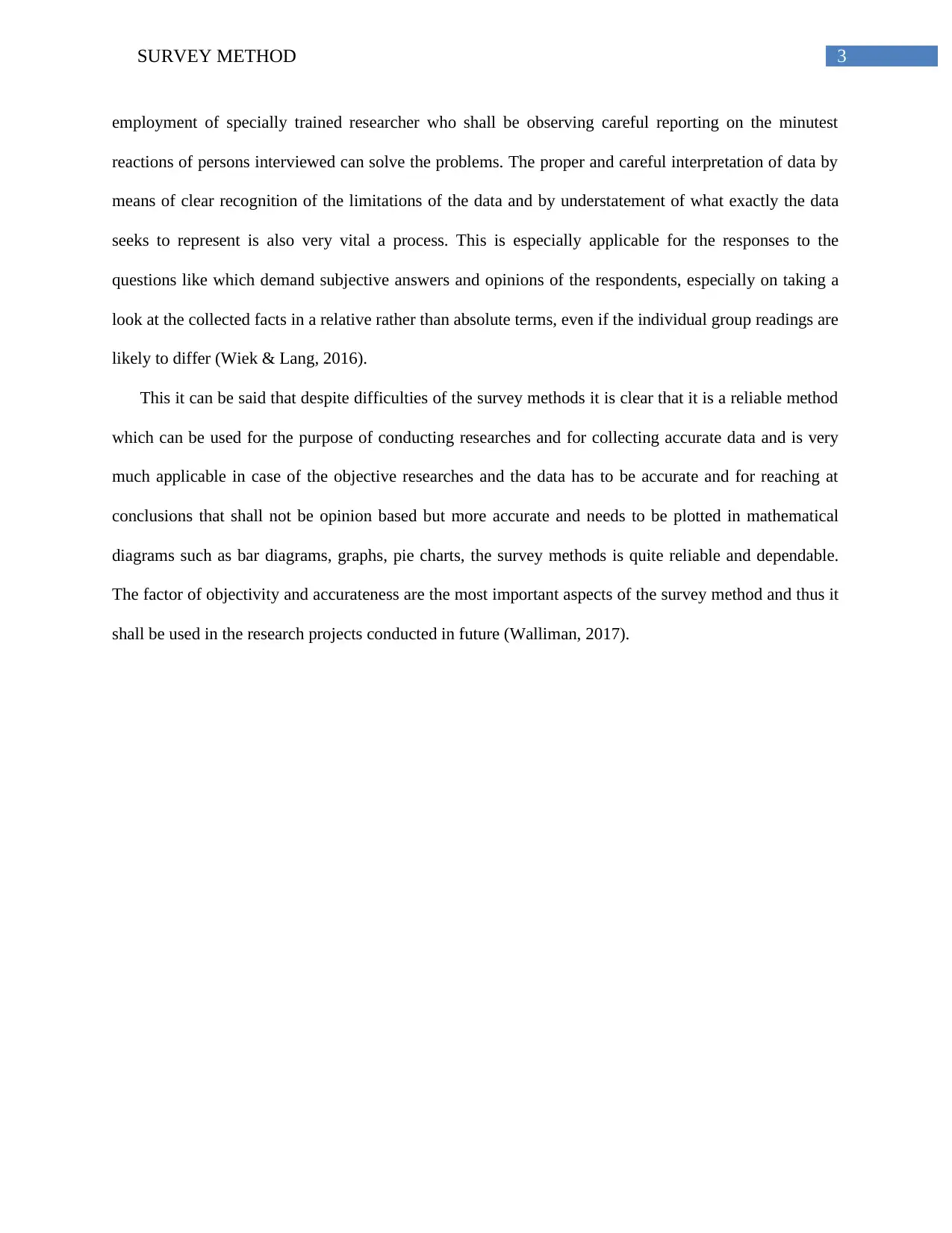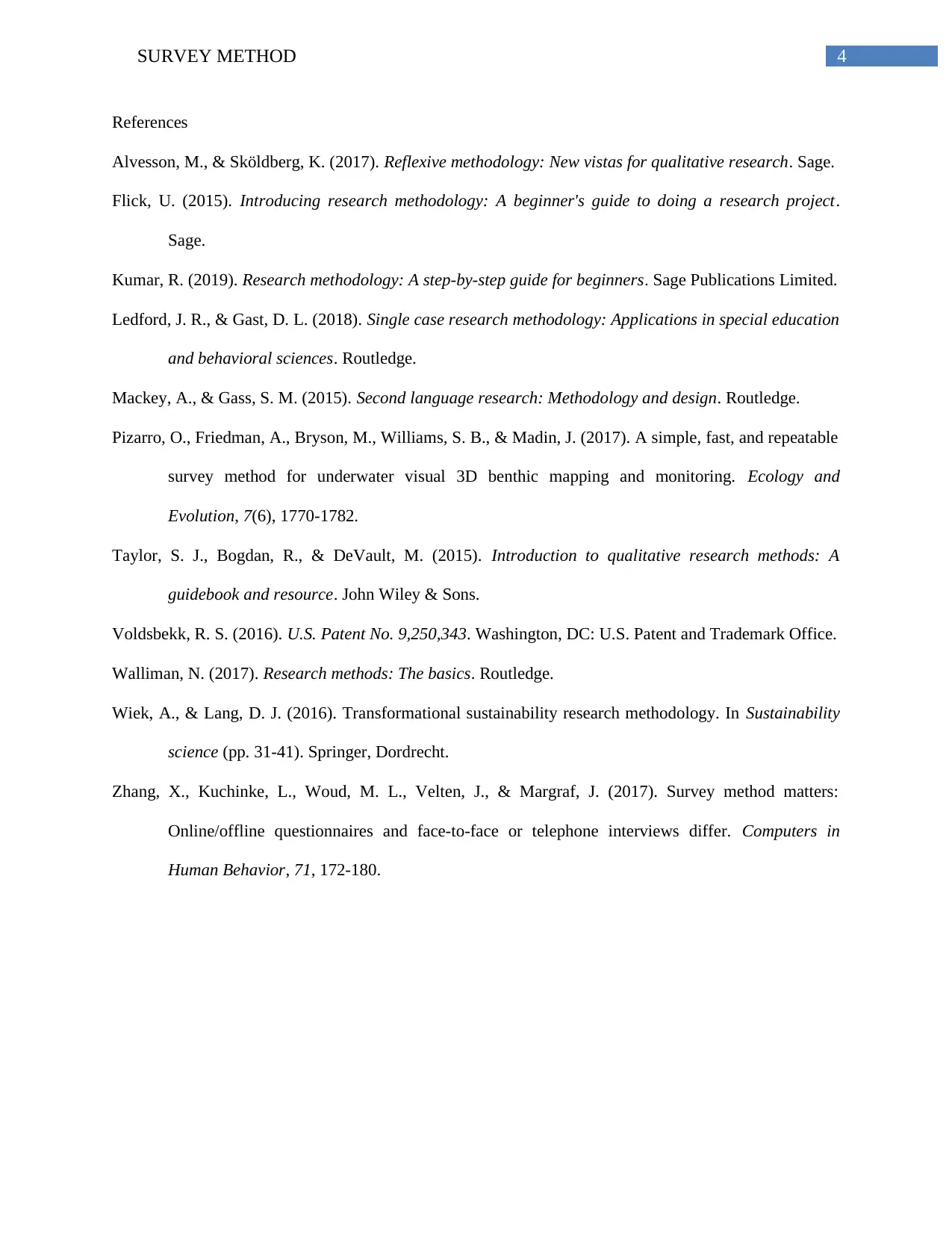Western Sydney University 102177: Survey Method Reflection Essay
VerifiedAdded on 2023/01/05
|5
|1463
|25
Essay
AI Summary
This essay provides a reflective account of the survey method, a key technique in social research. It begins by defining the survey method and its role in gathering research data through questionnaires and interactions with respondents. The essay then delves into the advantages of the survey method, such as its capacity to yield a wide range of information related to social and economic characteristics and its efficiency in terms of time and cost. However, it also acknowledges the disadvantages, including respondent unwillingness, memory lapses, and potential biases. The essay proposes strategies to overcome these limitations, like carefully framing questions, employing trained researchers, and interpreting data cautiously. Ultimately, the essay concludes that the survey method is a reliable and valuable tool for conducting objective research and collecting accurate data, especially when the goal is to reach conclusions based on factual evidence rather than opinions. The essay is well-structured, clearly articulating the advantages and disadvantages of the survey method and suggesting ways to mitigate the weaknesses, making it a useful resource for students studying research methods.

Running head: SURVEY METHOD
SURVEY METHOD
Name of the Student
Name of the University
Author Note
SURVEY METHOD
Name of the Student
Name of the University
Author Note
Paraphrase This Document
Need a fresh take? Get an instant paraphrase of this document with our AI Paraphraser

1SURVEY METHOD
The terms quantitative, qualitative and mixed methods for denoting methodologies for conducting
researches are actually umbrella terms which are broader in their scope and not specific. Thus they can
most appropriately be called as approaches instead of calling them methods for conducting researches.
Under the headship of the abovementioned approaches quantitative, qualitative and mixed methods, there
are specific methods such as interview method, survey method, questionnaire method, content analysis, et
cetera (Zhnag et al., 2017). Each of these methods could either be qualified as any of the three approaches
mentioned above quantitative, qualitative and mixed methods. Hence just mentioning quantitative,
qualitative or mixed method is not specific and tends to provide an inadequate and vague idea about the
method used by the researcher to conduct a particular research (Voldsbekk, 2016). In this particular piece
of reflection the focus shall be on provide a reflective account of the survey method. In the following
sections of the essay, a brief idea about the survey method shall be provided and its strength, its
weaknesses and the methods of overcoming them shall be provided with a reflective approach.
The Survey method is a technique or method of gathering reserach data by means of asking
questions to the people who are likely to form the sample or the focus group or the respondents whi are
also thought to be having the desired information and also the willingness to provide it. A formal list of
the questionnaire is supposed to be prepared before venturing into the field for collecting the data from
the concerned persons or the respondents (Pizarro et al., 2017). Generally a non disguised approach for
asking the questions is employed and before the securing of the necessary information it is necessary that
the proper information to the respondent is provided for the sake of an informed consent and to get the
maximum amount of information from the respondent. The respondents are usually asked questions
which are based on their demographic interest as per the opinion of the researcher and the respondent
alike. The employment of ethics is also quite important which must be adhered to for collecting
quantitative data (Kumar, 2019).
Having provided the idea about what survey method accounts for, a reflective account of its
advantages shall be provided. In comparison to most other methods for conduct researches such as the
direct observation method and the experimentation, the survey method tends to yield a greater and wider
The terms quantitative, qualitative and mixed methods for denoting methodologies for conducting
researches are actually umbrella terms which are broader in their scope and not specific. Thus they can
most appropriately be called as approaches instead of calling them methods for conducting researches.
Under the headship of the abovementioned approaches quantitative, qualitative and mixed methods, there
are specific methods such as interview method, survey method, questionnaire method, content analysis, et
cetera (Zhnag et al., 2017). Each of these methods could either be qualified as any of the three approaches
mentioned above quantitative, qualitative and mixed methods. Hence just mentioning quantitative,
qualitative or mixed method is not specific and tends to provide an inadequate and vague idea about the
method used by the researcher to conduct a particular research (Voldsbekk, 2016). In this particular piece
of reflection the focus shall be on provide a reflective account of the survey method. In the following
sections of the essay, a brief idea about the survey method shall be provided and its strength, its
weaknesses and the methods of overcoming them shall be provided with a reflective approach.
The Survey method is a technique or method of gathering reserach data by means of asking
questions to the people who are likely to form the sample or the focus group or the respondents whi are
also thought to be having the desired information and also the willingness to provide it. A formal list of
the questionnaire is supposed to be prepared before venturing into the field for collecting the data from
the concerned persons or the respondents (Pizarro et al., 2017). Generally a non disguised approach for
asking the questions is employed and before the securing of the necessary information it is necessary that
the proper information to the respondent is provided for the sake of an informed consent and to get the
maximum amount of information from the respondent. The respondents are usually asked questions
which are based on their demographic interest as per the opinion of the researcher and the respondent
alike. The employment of ethics is also quite important which must be adhered to for collecting
quantitative data (Kumar, 2019).
Having provided the idea about what survey method accounts for, a reflective account of its
advantages shall be provided. In comparison to most other methods for conduct researches such as the
direct observation method and the experimentation, the survey method tends to yield a greater and wider

2SURVEY METHOD
range and number of information. Survey method is thus effective for producing information which are
related to social and economic characteristics, attitudes, opinions, intentions et cetera and for the purpose
of gathering information for planning the product related features, in the advertisement media industry,
promotion of the sales, channels meant for distribution and for other marketing related variables (Mackey
& Gass, 2015). The method of handing down questions is a fast and cheap process that observation
cannot yield. Questionnaires are rather simpler in terms of administering. The data is also reliable. The
rate of variability of results collected can also be reduced, and on an overall basis it is relatively simpler fr
analyzing, quoting and interrelating the data that has been obtained by survey method to the research
questions, which makes it worthy of use in the research process (Taylor, Bogdan & DeVault, 2015).
There are also disadvantages of the Survey Method and much of it lies in the personal predisposition
of the respondents. The unwillingness of the respondents to reveal the information is a serious problem
and can be explained as the inadequate replies to the questions and it requires the display of diplomacy on
the part of the interviewer. The interviewer must assure that the information must be kept as a secret or
must apply the technique of offering some incentives against the response (Flick, 2015). The inability of
the respondents for providing information can be due to the following reasons:-
- Lacking of knowledge
- Lapsing of the memory
- Inability of identifying the motives and providing the reasons justifying the actions.
- The human biases of the respondents to withhold information (Alvesson & Sköldberg, 2017)
There are also other symantec inconveniences which are related to the factors such as the high level
of difficulty which might as well not be impossible but for stating an answer a given question in the
desired way so that it shall mean exactly the same thing to each respondent is also a factor. Similarly the
different wordings of the similar question shall frequently produce quite divergent results (Ledford &
Gast, 2018).
However the disadvantages can be overcome and can be used for conducting researches. Through the
calculative framing and phrasing of questions and calculative controlling of data gathering process by
range and number of information. Survey method is thus effective for producing information which are
related to social and economic characteristics, attitudes, opinions, intentions et cetera and for the purpose
of gathering information for planning the product related features, in the advertisement media industry,
promotion of the sales, channels meant for distribution and for other marketing related variables (Mackey
& Gass, 2015). The method of handing down questions is a fast and cheap process that observation
cannot yield. Questionnaires are rather simpler in terms of administering. The data is also reliable. The
rate of variability of results collected can also be reduced, and on an overall basis it is relatively simpler fr
analyzing, quoting and interrelating the data that has been obtained by survey method to the research
questions, which makes it worthy of use in the research process (Taylor, Bogdan & DeVault, 2015).
There are also disadvantages of the Survey Method and much of it lies in the personal predisposition
of the respondents. The unwillingness of the respondents to reveal the information is a serious problem
and can be explained as the inadequate replies to the questions and it requires the display of diplomacy on
the part of the interviewer. The interviewer must assure that the information must be kept as a secret or
must apply the technique of offering some incentives against the response (Flick, 2015). The inability of
the respondents for providing information can be due to the following reasons:-
- Lacking of knowledge
- Lapsing of the memory
- Inability of identifying the motives and providing the reasons justifying the actions.
- The human biases of the respondents to withhold information (Alvesson & Sköldberg, 2017)
There are also other symantec inconveniences which are related to the factors such as the high level
of difficulty which might as well not be impossible but for stating an answer a given question in the
desired way so that it shall mean exactly the same thing to each respondent is also a factor. Similarly the
different wordings of the similar question shall frequently produce quite divergent results (Ledford &
Gast, 2018).
However the disadvantages can be overcome and can be used for conducting researches. Through the
calculative framing and phrasing of questions and calculative controlling of data gathering process by
⊘ This is a preview!⊘
Do you want full access?
Subscribe today to unlock all pages.

Trusted by 1+ million students worldwide

3SURVEY METHOD
employment of specially trained researcher who shall be observing careful reporting on the minutest
reactions of persons interviewed can solve the problems. The proper and careful interpretation of data by
means of clear recognition of the limitations of the data and by understatement of what exactly the data
seeks to represent is also very vital a process. This is especially applicable for the responses to the
questions like which demand subjective answers and opinions of the respondents, especially on taking a
look at the collected facts in a relative rather than absolute terms, even if the individual group readings are
likely to differ (Wiek & Lang, 2016).
This it can be said that despite difficulties of the survey methods it is clear that it is a reliable method
which can be used for the purpose of conducting researches and for collecting accurate data and is very
much applicable in case of the objective researches and the data has to be accurate and for reaching at
conclusions that shall not be opinion based but more accurate and needs to be plotted in mathematical
diagrams such as bar diagrams, graphs, pie charts, the survey methods is quite reliable and dependable.
The factor of objectivity and accurateness are the most important aspects of the survey method and thus it
shall be used in the research projects conducted in future (Walliman, 2017).
employment of specially trained researcher who shall be observing careful reporting on the minutest
reactions of persons interviewed can solve the problems. The proper and careful interpretation of data by
means of clear recognition of the limitations of the data and by understatement of what exactly the data
seeks to represent is also very vital a process. This is especially applicable for the responses to the
questions like which demand subjective answers and opinions of the respondents, especially on taking a
look at the collected facts in a relative rather than absolute terms, even if the individual group readings are
likely to differ (Wiek & Lang, 2016).
This it can be said that despite difficulties of the survey methods it is clear that it is a reliable method
which can be used for the purpose of conducting researches and for collecting accurate data and is very
much applicable in case of the objective researches and the data has to be accurate and for reaching at
conclusions that shall not be opinion based but more accurate and needs to be plotted in mathematical
diagrams such as bar diagrams, graphs, pie charts, the survey methods is quite reliable and dependable.
The factor of objectivity and accurateness are the most important aspects of the survey method and thus it
shall be used in the research projects conducted in future (Walliman, 2017).
Paraphrase This Document
Need a fresh take? Get an instant paraphrase of this document with our AI Paraphraser

4SURVEY METHOD
References
Alvesson, M., & Sköldberg, K. (2017). Reflexive methodology: New vistas for qualitative research. Sage.
Flick, U. (2015). Introducing research methodology: A beginner's guide to doing a research project.
Sage.
Kumar, R. (2019). Research methodology: A step-by-step guide for beginners. Sage Publications Limited.
Ledford, J. R., & Gast, D. L. (2018). Single case research methodology: Applications in special education
and behavioral sciences. Routledge.
Mackey, A., & Gass, S. M. (2015). Second language research: Methodology and design. Routledge.
Pizarro, O., Friedman, A., Bryson, M., Williams, S. B., & Madin, J. (2017). A simple, fast, and repeatable
survey method for underwater visual 3D benthic mapping and monitoring. Ecology and
Evolution, 7(6), 1770-1782.
Taylor, S. J., Bogdan, R., & DeVault, M. (2015). Introduction to qualitative research methods: A
guidebook and resource. John Wiley & Sons.
Voldsbekk, R. S. (2016). U.S. Patent No. 9,250,343. Washington, DC: U.S. Patent and Trademark Office.
Walliman, N. (2017). Research methods: The basics. Routledge.
Wiek, A., & Lang, D. J. (2016). Transformational sustainability research methodology. In Sustainability
science (pp. 31-41). Springer, Dordrecht.
Zhang, X., Kuchinke, L., Woud, M. L., Velten, J., & Margraf, J. (2017). Survey method matters:
Online/offline questionnaires and face-to-face or telephone interviews differ. Computers in
Human Behavior, 71, 172-180.
References
Alvesson, M., & Sköldberg, K. (2017). Reflexive methodology: New vistas for qualitative research. Sage.
Flick, U. (2015). Introducing research methodology: A beginner's guide to doing a research project.
Sage.
Kumar, R. (2019). Research methodology: A step-by-step guide for beginners. Sage Publications Limited.
Ledford, J. R., & Gast, D. L. (2018). Single case research methodology: Applications in special education
and behavioral sciences. Routledge.
Mackey, A., & Gass, S. M. (2015). Second language research: Methodology and design. Routledge.
Pizarro, O., Friedman, A., Bryson, M., Williams, S. B., & Madin, J. (2017). A simple, fast, and repeatable
survey method for underwater visual 3D benthic mapping and monitoring. Ecology and
Evolution, 7(6), 1770-1782.
Taylor, S. J., Bogdan, R., & DeVault, M. (2015). Introduction to qualitative research methods: A
guidebook and resource. John Wiley & Sons.
Voldsbekk, R. S. (2016). U.S. Patent No. 9,250,343. Washington, DC: U.S. Patent and Trademark Office.
Walliman, N. (2017). Research methods: The basics. Routledge.
Wiek, A., & Lang, D. J. (2016). Transformational sustainability research methodology. In Sustainability
science (pp. 31-41). Springer, Dordrecht.
Zhang, X., Kuchinke, L., Woud, M. L., Velten, J., & Margraf, J. (2017). Survey method matters:
Online/offline questionnaires and face-to-face or telephone interviews differ. Computers in
Human Behavior, 71, 172-180.
1 out of 5
Related Documents
Your All-in-One AI-Powered Toolkit for Academic Success.
+13062052269
info@desklib.com
Available 24*7 on WhatsApp / Email
![[object Object]](/_next/static/media/star-bottom.7253800d.svg)
Unlock your academic potential
Copyright © 2020–2025 A2Z Services. All Rights Reserved. Developed and managed by ZUCOL.




